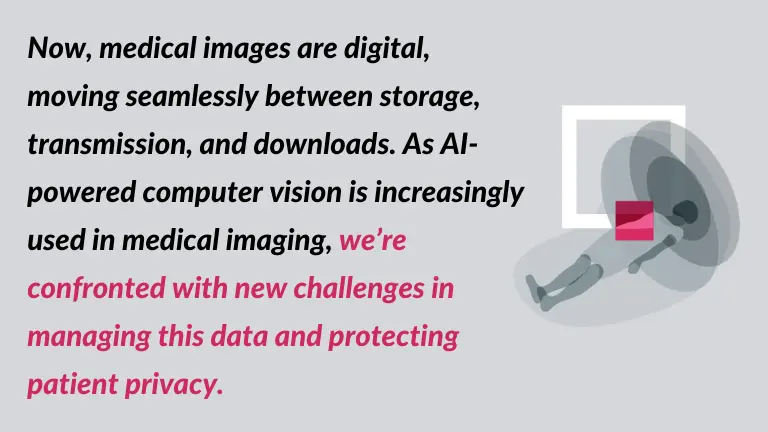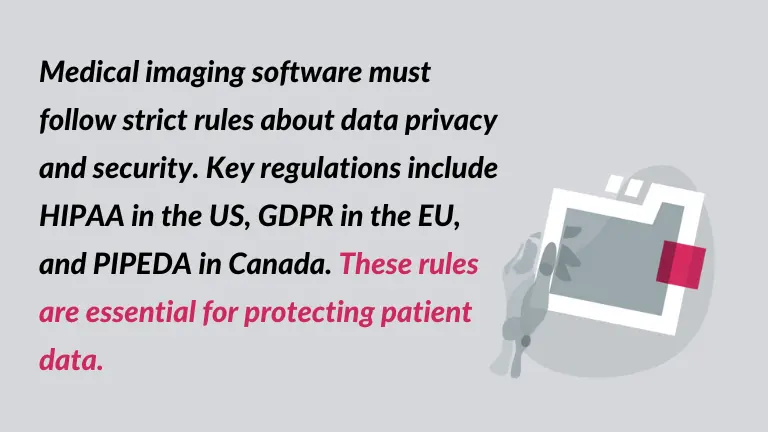Medical imaging data: privacy and security
Today, in the era of modern medicine, medical imaging software development is essential for patient diagnosis and treatment. However, the security and privacy of medical imaging data have become major concerns as imaging systems handle an increasing amount of sensitive patient information. In addition to being required by law, ensuring the security of sensitive data is crucial for preserving public confidence in healthcare services.
Two decades ago, practitioners typically printed digital medical images onto film. X-rays were stored in physical folders, which, while not entirely secure, didn’t pose the same privacy risks as today. At the present time, medical images are digital, moving seamlessly between storage, transmission, and downloads. As AI-powered computer vision is increasingly used in medical imaging, we’re confronted with new challenges in managing this data and protecting patient privacy. [1]
Understanding risks
Let’s start by sorting out the risks that come with the privacy of medical imaging data. Because medical imaging software handles extremely private patient data, it is one of the prime targets for security flaws and hacks. Strong security measures must be implemented after possible hazards have been identified:
- Unauthorized Access: patient information may be misused for discrimination, financial, or identity theft when accessed by unapproved parties.
- Data breaches: unauthorized exposure, tampering, or loss of vital data can result from external threats like ransomware, as well as hacking that undermines the integrity of patient information.
- Internal Threats: insider risks have the potential to compromise data security and privacy through both unintentional employee abuse and accidental data exposure. [2]
Medical scans and their place in the structure of data
In various industries, particularly in the field of medicine, concerns about individual privacy are intensifying in the era of big data, as different types of data can potentially contain personally identifiable information.
Medical images hold a distinct place within health information, as they share certain features commonly found in structured data within electronic health records, such as lab results, medication dosages, and physiological metrics.
Text-based health records are relatively simple to collect and anonymize. Organizations often share them for tasks like quality checks, data analysis, and billing.
Conversely, the distribution of tissue samples and the use of deidentified genomic data for secondary research typically require explicit patient consent. Radiologic images occupy a middle ground between these types of data. Radiological images fall somewhere in between. They’re easy to share but contain highly personal information. [3]

Compliance with regulatory standards
Medical imaging software must follow strict rules about data privacy and security. Key regulations include HIPAA in the US, GDPR in the EU, and PIPEDA in Canada.
These rules are essential for protecting patient data. Certainly, software developers need to understand the specific requirements of these regulations, which often involve using encryption, controlling access, keeping records, and limiting the amount of data collected.
How to protect the privacy of medical data – best practices
1. Encryption is a basic step towards protecting patient data
Both in transit (when transferred across a network) and at rest (when kept in a database or archive), medical imaging data and any related patient data should be encrypted. [4]
2. Thorough risk assessment
To identify vulnerabilities and prioritize mitigation measures, regularly conduct risk assessments.
3. Robust access controls
To limit access to authorized personnel, implement strong access controls such as encryption, role-based access, and multi-factor authentication.
4. Backup and disaster recovery plans
By securely backing up data and ensuring efficient restoration in the event of a disaster, healthcare organizations maintain continuous operations while upholding patient privacy and regulatory compliance.
5. Consistent security updates
Update operating systems and software with the most recent security updates to fix vulnerabilities.
6. Safe data storage
Make sure data is kept in cloud settings or data centers that comply with security regulations and have the necessary security measures in place.
7. Employee awareness and training
Educate staff members thoroughly on data security and privacy best practices, including how to spot and report unusual conduct. [5]

8. Pseudonymization and anonymization
Anonymization removes all identifying information from data, ensuring complete privacy. Pseudonymization replaces personal identifiers with codes, maintaining some ability to re-identify data if needed. Both methods are crucial for following data privacy laws and handling medical images ethically, especially as imaging technology becomes more widespread in research and healthcare. [6]
Ensuring patient data security is our top priority
Security and privacy of medical imaging data are essential for the development and upkeep of software. Moreover, healthcare providers can ensure the safety of patient data by implementing best practices.
Because cyber threats continue to evolve, it is increasingly important for healthcare organizations and software developers to stay proactive in protecting sensitive patient information. What’s more, prioritizing data privacy and security allows medical organizations to safeguard patient information, maintain trust, and comply with regulatory requirements.
Resources
[1], [3] Lotan E., MD, PhD, Tschider Ch., PhD, Sodickson D. K., MD, PhD, Caplan A.L., PhD, Bruno M., B.Sc. R.T.(R)(MR), Zhang B., MSc, Lui Y.W., MD: Medical Imaging and Privacy in the Era of Artificial Intelligence: Myth, Fallacy, and the Future, Journal of the American College of Radiology, September 2020, https://www.jacr.org/article/S1546-1440(20)30385-9/fulltext.
[2] Data security and protection in medical imaging – an overview, January 18, 2023, https://blog.medicai.io/en/data-security-and-protection-in-medical-imaging-an-overview#:~:text=Unauthorized%20access%2C%20manipulation%2C%20or%20loss,financial%20losses%20and%20legal%20penalties.
[4], [5] Eichelberg M., Kleber K., Kämmerer M., Cybersecurity in PACS and Medical Imaging: an Overview, October 2020, https://link.springer.com/article/10.1007/s10278-020-00393-3
[6] van Ooijen, Peter; Aryanto, Kadek Yota Ernanda, Pseudonymization and Anonymization of Radiology Data, Basic Knowledge of Medical Imaging Informatics, 2021, https://link.springer.com/chapter/10.1007/978-3-030-71885-5_7